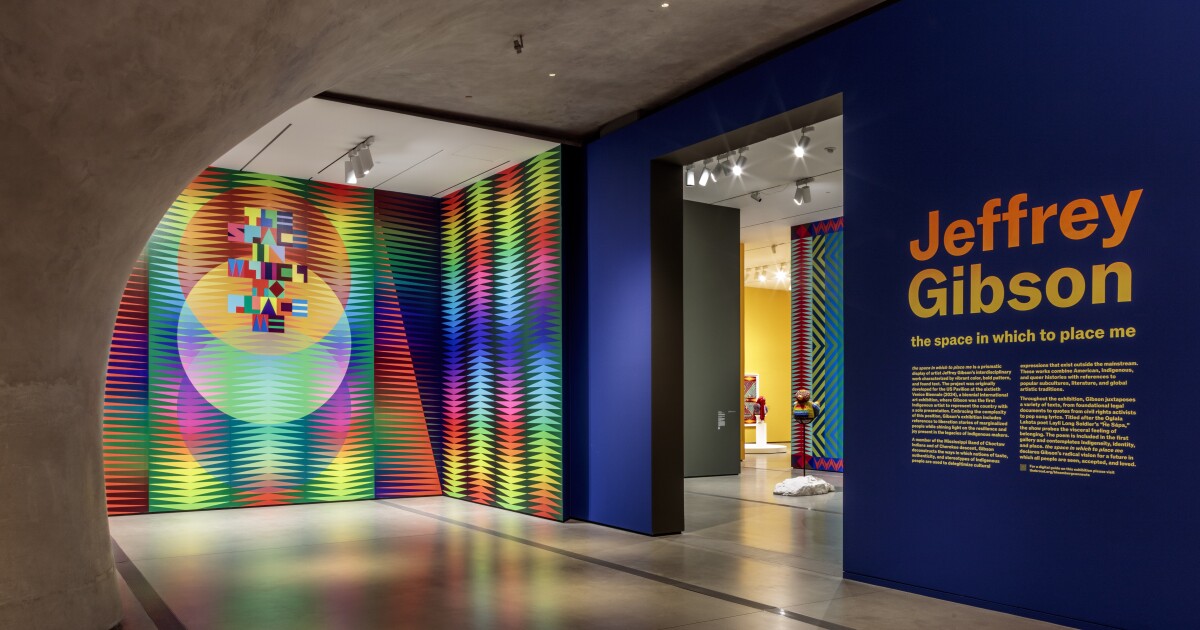Keep up with LAist.
If you’re enjoying this article, you’ll love our daily newsletter, The LA Report. Each weekday, catch up on the 5 most pressing stories to start your morning in 3 minutes or less.
When you walk into “Jeffrey Gibson: the space in which to place me” at The Broad museum in downtown L.A., you are blasted with the sound of “Sisters” by The Halluci Nation, a First Nations electronic music group. The music is the backdrop to a video that Gibson first created specifically for the screens of New York’s Times Square in 2019, for a piece titled “She Never Dances Alone,” which is on view in the show. The music pulsates and makes you feel like you might be at a club, not a museum.
It’s not just your ears that are inundated. The colors on display throughout the show are so bright, it feels like your retinas might be on fire. The overwhelming sensory experience mirrors the expansiveness of the show itself — its history, subjects and mediums stretching wide in scope.

Sculptures titled “WE WANT TO BE FREE” and “The Enforcer” by artist Jeffrey Gibson.
(
Joshua White/JWPictures.com
/
Courtesy The Broad
)
Gibson pairs Indigenous beadwork with unexpected objects like a punching bag or the bust of a man that would otherwise be more in the style of a Roman or Greek sculpture. He includes quotes from figures like Fredrick Douglass and Nina Simone within the works — as if camouflaged — within murals that feature intricate patterns that look like woven textiles.
Who is Jeffrey Gibson?
Today, Gibson lives in upstate New York, in the Hudson Valley area, with his husband, artist Rune Olsen, and their two children. Gibson’s father was a civil engineer for the U.S. Department of Defense, so he moved around a lot growing up. He spent time in Colorado and North Carolina, as well as Germany and Korea. He is of Choctaw and Cherokee descent.

Beaded busts on display as part of the “Jeffrey Gibson: the space in which to place me” exhibition at The Broad.
(
Joshua White/JWPictures.com
/
Courtesy The Broad
)
While he had a slow start to his career as a struggling artist living in New York City in the aughts — making art between his day jobs at Macy’s and Ikea — he caught a break in 2012 working with other Indigenous artists as part of a two-gallery exhibition in New York, titled “one becomes the other.” In 2019, he received a MacArthur Fellowship, commonly called “the genius grant.” Then he was selected to represent the U.S. as part of the 60th Venice Biennale in 2024, becoming the first Indigenous artist to display a solo show at the Biennale from any country.
Best time to see the show
“Jeffrey Gibson: the space in which to place me” will be on view for free the weekend of The Broad’s 10-Year Anniversary Weekend, Sept. 20 and 21.
In addition to free access to the work, museum representatives say there will be “party favors.”
There also will be live music the evening of the Sept. 20 as part of a ticketed event featuring an all-Indigenous lineup, including Angélica Garcia, M’lynn and Joe Rainey.
